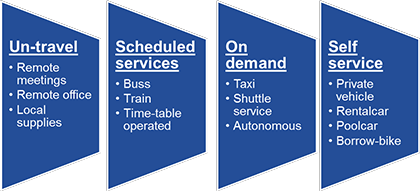Strategic Outlook
This work package contributes with an international perspective on mobility and
accessibility services as well as developments of digital platforms. Focus is on
services and platforms that have the potential to contribute to sustainability goals.
Aim and Research questions
The first aim of this work package is to identify promising accessibility service innovations (ASIs), which can have an impact on reduced transport needs and on more optimized use of current infrastructure. The second aim of the work package is to identify characteristics of successful multisided digital platforms (MSDP), which can facilitate the combination of ASIs and enabling direct interactions between different service providers and groups of users (i.e. Amazon, Facebook, Airbnb (dwelling owners and renters) eBay (buyers and sellers) the Uber app (drivers and passengers), Sony’s PlayStation (game developers and users)) (
Hagiu, 2014
). Part of this aim is to identify how other industry sectors manage congestible infrastructures (such as telecom and energy
sector).
Research questions addressed:
- Which are the most promising ASIs that allows to reduce transport demand and/or to
use the transport infrastructure and vehicles in a more optimized/sustainable way for
transport of goods and people? - What characterizes successful MSDPs?
Context of this work package
This work package provides useful input to Work Package 4: Understanding user needs and institutional conditions as key aspects , and Work Package 5: Designing and testing accessibility services and platforms .
Specific output will be a report with:
1) identified most promising mobility and accessibility services and
2) key issues in order to reach a successful implementation for combinations of
proposed services.
3) characteristics of MSDPs and
4) key issues in order to reach a successful implementation of 2) in the context of
advanced MSDPs.
Work package leader
Tasks
Task 3.1: Strategic outlook of ASIs
The aim of this task is to identify services that allows to reduce transport demand and/or to use the transport infrastructure and vehicles in a more optimized/sustainable way ( Santos et. al 2010 , Litman 2015 ).
The following research questions will be addressed:
- Which are the most promising examples of ASIs and combinations of Untravel,
Scheduled transport, Self-service and On-demand services from an enduser
perspective. - Which are the key reasons why promising examples can succeed and why
have other ideas and trials failed? - How are different actors involved in the above identified examples? Which
business models are and can be used? Who are potential new entrants?
The task will be based on literature reviews of scientific, official as well as other documents and on interviews with international experts as well as focus group meetings with stakeholders.

As more and more businesses are digitalized, it means that they can be connected in new and efficient combinations ( Ng 2014 , Osterwalder and Pigneur 2010 , Heikkilä et al 2015 ). In task 3.1 the focus is to identify both services within the different focus areas (Un- travel, Scheduled transport, On-demand and Self-service) and combinations and integrations of these. The task will also identify the actors involved in providing these services as well as to identify new entrants. Special attention is given to innovations with disruptive potential, meaning radical changes in the way that needs and desires are met from both users’ and producers’ perspectives.
User value and users participating
This task will give important input about the most promising ASIs, realised and envisioned, in order to understand which works well and which doesn’t work when it comes to reduction of energy use and emissions.
International co-operation
In this task our international research co-operations will play an important role to support with knowledge from their horizon.
Task 3.2 Strategic outlook on MSDPs
In this task the focus lies on existing and anticipated MSDPs. The aim is to identify the most advanced examples, plans and visions when it comes to MSDPs.
The following research questions will be addressed:
- How have such platforms emerged and what type of actors have been involved?
- Which mechanisms make the platforms usage widespread?
- Which business models are used?
- What roles have different stakeholders taken?
- Who are potential new entrants?
- Which strategic economic instruments can be used to make ASI attractive?
- How do other industries (i.e. other than the transport sector) manage congestible infrastructure resources and huge fluctuations in demand?
The task will be based on literature reviews of scientific, official and other documents and on interviews with international experts. The implementation of multisided platforms has had a strong impact on many branches resulting in disruptive innovations as well as creative destruction, blurring traditional boundaries between markets. The development is driven by reductions in searching and transaction costs for users, network effects and economic of scale. New business models evolve and so do new types of collaborative innovation processes. At the same time, proprietors of successful platforms get rich and powerful but also totally dependent on users operations, making user adjustment a key challenge in service production. Other services characterized by infrastructural limitations and considerable fluctuations in demand such as for example energy and telecom infrastructures will also be taken in consideration.
User value and users participating
This task will give important input about the research front of MSDPs, how it functions in different contexts. It will also take in consideration existing and anticipated multisided digital platforms for different purposes but with a special interest in transport (physical movement of people and goods. The users participating in this task are platform providers, ASI providers and users. They are mainly interested in the services provided by the MSDP.
International co-operation
In this task our international research co-operations will play an important role to support with knowledge from their horizons.
